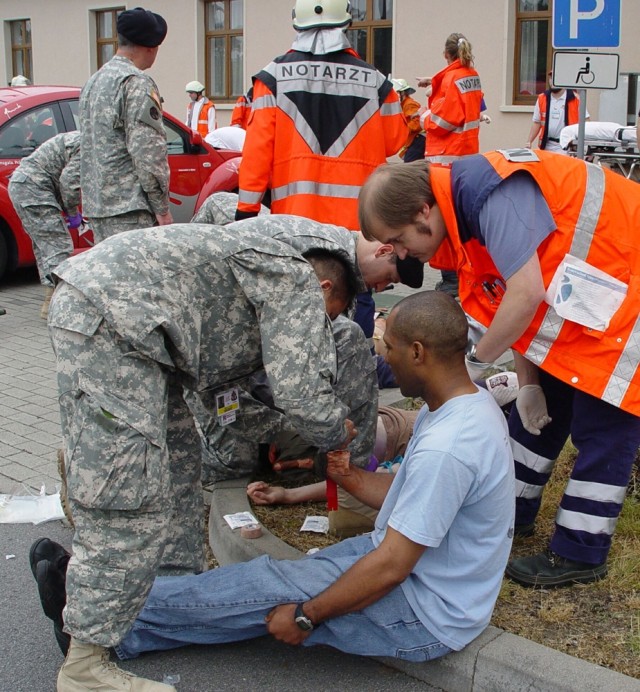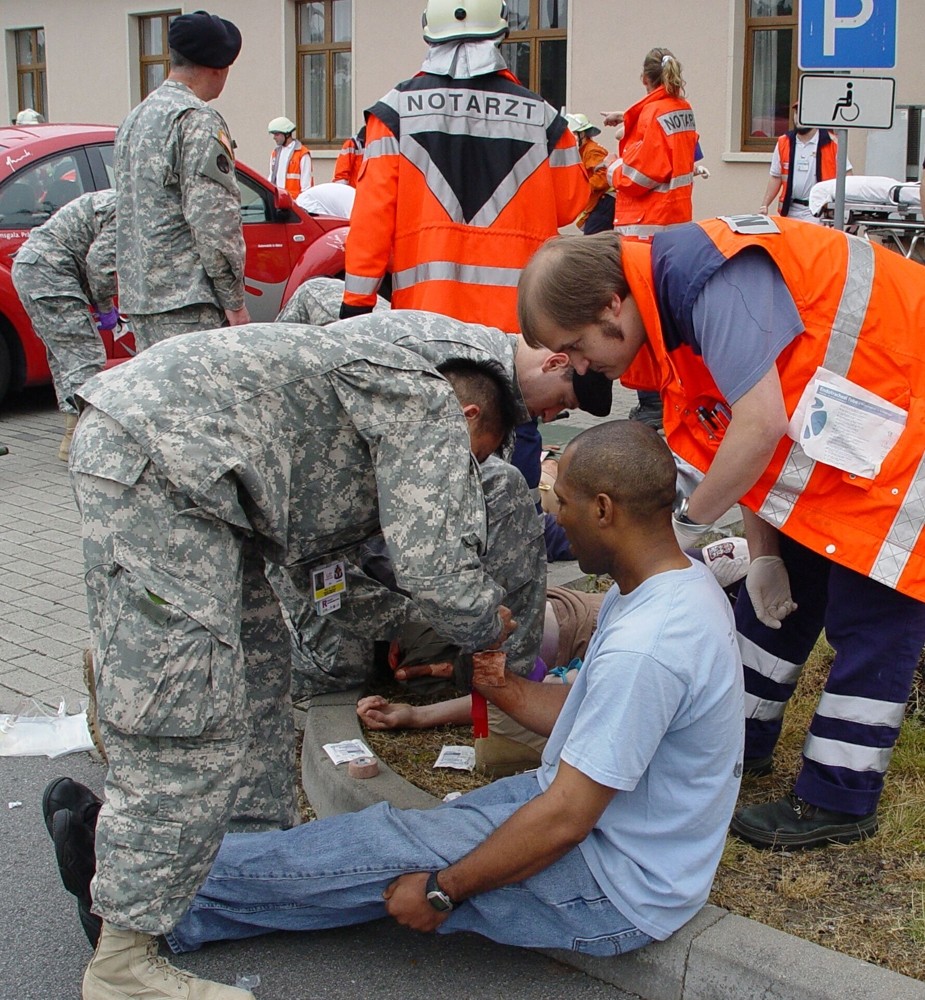MANNHEIM, Germany - New procedures aimed at improving the synchronization of Army and host nation emergency responders were tested here May 31.
The realistic scenario had some 180 German firefighters, policemen and paramedics rescuing and treating roughly 40 American "casualties" following a simulated explosion on U.S. Army Garrison Mannheim.
The exercise started shortly after 9 a.m., when an explosion rocked the Sullivan Barracks gymnasium. Casualties with various wounds screamed for help. Two military police patrol cars initially responded, with young Soldiers grabbing first-aid kits and rushing to help the injured.
Within minutes, the MPs had moved a surprising numbers of injured away from the immediate danger zone.
Watching the events unfold, one host nation observer/controller complimented the MPs for "moving in and out of the danger zone without regard for their own safety."
His U.S. counterpart quickly pointed out though: "Most of these Soldiers have been deployed to Iraq or Afghanistan, where it is [paramount] to get casualties out of the immediate danger zone. In this exercise, they should have checked for secondary devices. But ... that's why we do these types of exercises, so that we can learn from mistakes."
The first German medical rescuers arrived about 15 minutes after the explosion. Because the first 30 minutes are vital in treating serious injuries - and with limited outside access to military installations during a crisis - Dr. Arndt Bublitz, lead emergency physician, and Andre Kuehner, disaster protection chief for Baden-Wuerttemberg's Johanniter-Unfall-Hilfe (medical rescue organization), delivered a plan to use pre-determined entry routes and facilities on post to establish emergency treatment areas.
Except for a few minor access glitches, the German emergency vehicles quickly made their way to the incident site. Once there, medical teams performed first aid and initial triage at a spontaneously created casualty collection point. Afterwards, they began transporting injured to the garrison's sports arena, one of three pre-determined emergency treatment areas within the Benjamin Franklin Village and Sullivan Barracks complex.
Establishing an emergency treatment center is in accordance with host nation disaster protection. German hospitals do not own large emergency rooms, meaning they would be quickly overwhelmed by a sudden large influx of patients. Therefore, initial patient stabilization is made away from the immediate emergency area, with the injured then transported to a hospital equipped with the best gear and staff to treat such injuries.
Back at the garrison's sports arena, four mobile intensive care units were established within minutes, along with further treatment areas divided into four injury categories.
"Our goal is not to transport the chaos of an incident site into the hospitals, because they simply do not have the necessary capacity," said Klaus Handermann, chief of disaster protection for Mannheim.
"You can't project the disaster into the hospital," added Bublitz.
About 90 minutes were needed to treat every casualty, although it appeared that some "minor injuries" were suddenly unaccounted for ... they simply walked away after being treated.
Overall, the exercise validated the new concept's premise, but there were minor glitches in communication, both among German and Americans, but also internal to all participating organizations. "But that is why we have these events - [to] fix such problems," said Lt. Col. Jeffrey Fletcher, commander of USAG Mannheim.
Overall, "We validated several plans with this year's consequence management exercise," Fletcher said, "and we have made significant improvements from our last event in 2006."
Noting that there is always room for improvement, he added that the garrison will continue to work closely its German counterparts, "ensuring we remain at a high state of readiness in the event we are required to respond in a real-world situation."


Social Sharing